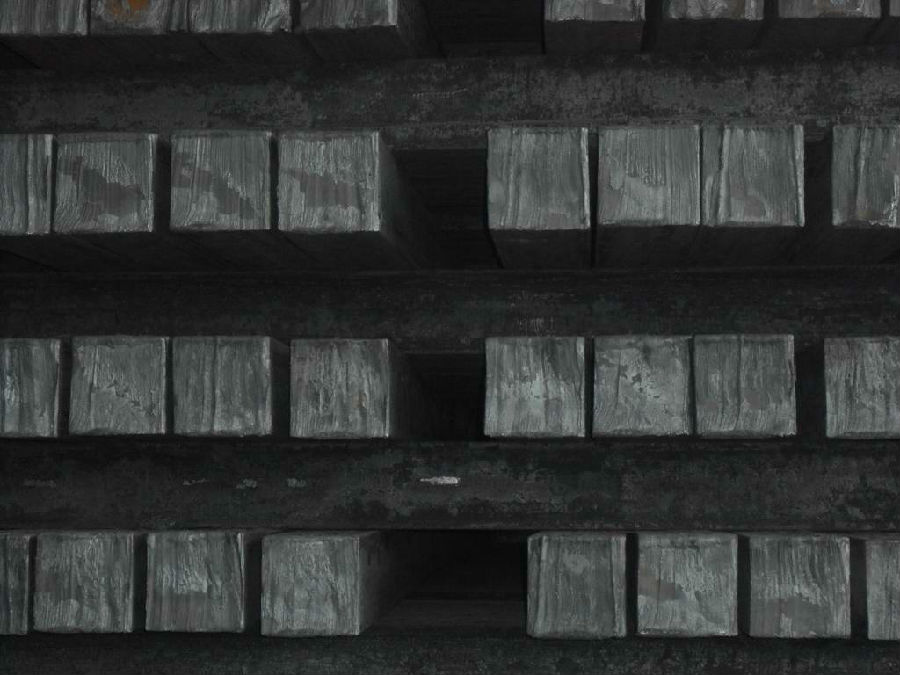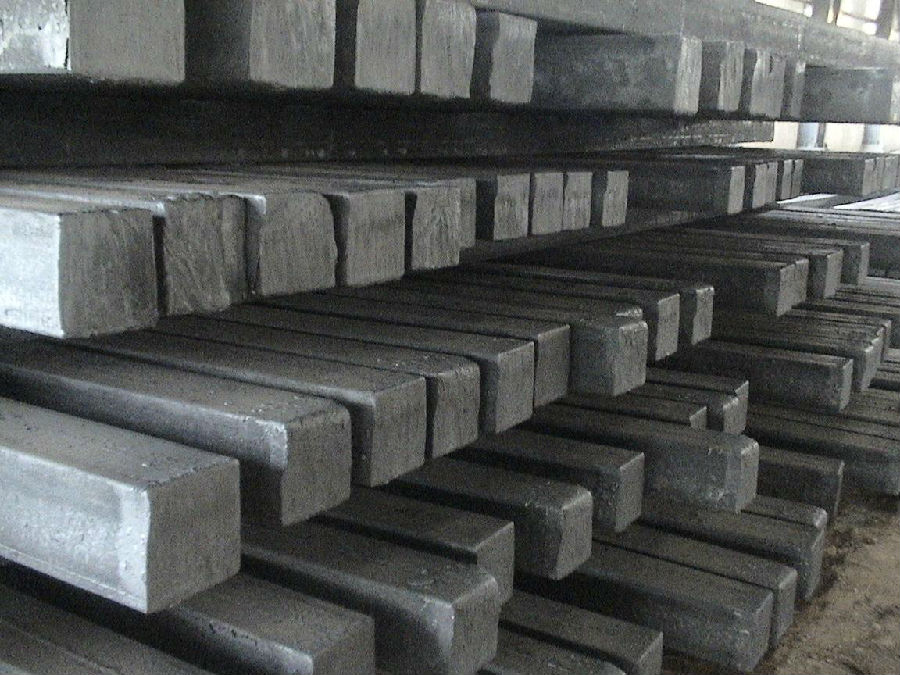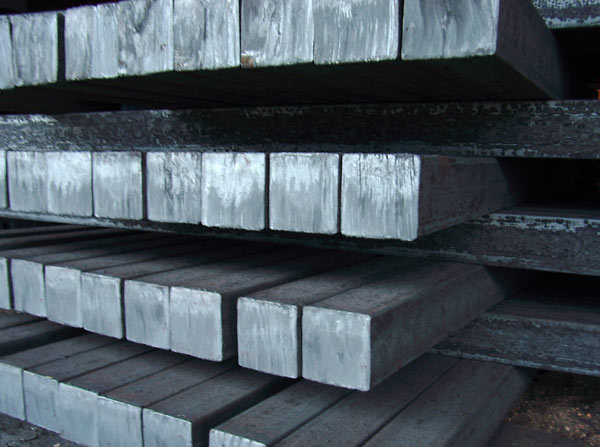Carbon Steel Billets Square Billets High Quality
- Loading Port:
- Tianjin
- Payment Terms:
- TT OR LC
- Min Order Qty:
- 24 m.t.
- Supply Capability:
- 24000 m.t./month
OKorder Service Pledge
OKorder Financial Service
You Might Also Like
Specifications
square steel billets 3sp & 5sp grade
1.3SP, 5SP
2.terms of payment: L/C at sight
3.size: 50~150mm
4.length: 5.8~12m
Specifications
| product name | square steel billets 3sp & 5sp grade |
| main types |
|
| size |
|
| application | 1.M.S. Billets are used for rolling of TMT Re-Bars of Fe415 and Fe500 Grade and various other structural steel products. 2.CRS Billets are used fro rolling of CRS TMT Re-Bars. 3.Special Alloy Billets are used for rolling of any special grade TMT Re-Bars like Earthquake resistant TMT Re-Bars and for special grade structural steel products. |
| notes | We produce world class quality steel billets which meets the specific requirements of the clients |



- Q:What is the difference between a steel billet and a steel bar?
- A steel billet is a semi-finished product that is typically square or rectangular in shape and has a larger cross-sectional area compared to a steel bar. It is produced through the casting or rolling process and serves as raw material for further processing. On the other hand, a steel bar is a fully finished product that is typically round, hexagonal, or square in shape and has a smaller cross-sectional area. It is obtained by hot or cold working the steel billet through processes like rolling or drawing.
- Q:Are steel billets recyclable?
- Yes, steel billets are recyclable.
- Q:How are steel billets used in the production of industrial valves?
- Steel billets are used in the production of industrial valves as they serve as the raw material for shaping and forming various valve components, such as bodies, bonnets, stems, and discs. Through machining, forging, and welding processes, the steel billets are transformed into the required shapes and sizes, ensuring the strength and durability of the valves.
- Q:What are the main factors affecting the quality of steel billets?
- There are several main factors that can significantly affect the quality of steel billets. These factors include the composition of the steel, the temperature and time of the heating process, the cooling rate, and the presence of impurities. Firstly, the composition of the steel plays a crucial role in determining its quality. The presence of certain elements such as carbon, manganese, and silicon can affect the mechanical properties of the steel, including its strength and hardness. The proper control and balance of these alloying elements are essential to ensure the desired quality of the steel billets. Secondly, the temperature and time of the heating process during the production of steel billets are critical factors. The heating process must be carefully controlled to achieve the optimal temperature for the desired transformation of the microstructure. Overheating or underheating can lead to the formation of undesirable phases or an inconsistent microstructure, which can negatively impact the quality of the billets. The cooling rate is another important factor affecting the quality of steel billets. The cooling process needs to be controlled to achieve the desired microstructure and mechanical properties. Too rapid cooling can result in the formation of brittle phases or residual stresses, while slow cooling can lead to coarse-grained structures with reduced strength. Furthermore, the presence of impurities in the steel can significantly affect its quality. Impurities such as sulfur, phosphorus, and non-metallic inclusions can decrease the mechanical properties and promote the formation of defects in the steel billets. Therefore, strict control of the raw materials and the implementation of effective refining techniques are necessary to minimize the presence of impurities. In conclusion, the main factors affecting the quality of steel billets are the composition of the steel, the temperature and time of the heating process, the cooling rate, and the presence of impurities. By carefully controlling and optimizing these factors, steel manufacturers can produce high-quality billets that meet the desired specifications and performance requirements.
- Q:What are the different types of surface treatment methods used for steel billets?
- There are several different types of surface treatment methods used for steel billets, each serving a specific purpose. Here are some of the commonly used methods: 1. Pickling: This method involves immersing the steel billets in an acidic solution, usually hydrochloric or sulfuric acid, to remove any scale or oxide layers on the surface. Pickling helps to improve the surface finish and prepares the steel for further processing. 2. Shot Blasting: Shot blasting involves propelling small metal or ceramic particles at high velocity onto the surface of the steel billets. This process helps to remove any rust, scale, or contaminants from the surface, resulting in a clean and smooth finish. 3. Grinding: Grinding is a mechanical process where abrasive wheels are used to remove any imperfections on the surface of the steel billets. This method can be used to achieve a specific surface roughness and is commonly employed when precision and accuracy are required. 4. Acid Etching: Acid etching is a chemical process that involves applying an acid solution to the surface of the steel billets. This method is used to create a controlled roughness or texture on the surface, which can enhance the adhesion of subsequent coatings or paints. 5. Galvanizing: Galvanizing is a popular surface treatment method where a layer of zinc is applied to the steel billets. This process provides excellent corrosion resistance, as the zinc acts as a sacrificial barrier that protects the underlying steel from oxidation. 6. Powder Coating: Powder coating is a technique where a dry powder is electrostatically applied to the surface of the steel billets. The coated billets are then heated, causing the powder to melt and form a protective layer. This method is known for its durability, resistance to corrosion, and ability to provide a wide range of decorative finishes. 7. Passivation: Passivation is a chemical process that aims to improve the corrosion resistance of stainless steel billets. It involves the removal of any iron contaminants from the surface and the formation of a passive oxide layer, which protects the steel from oxidation. These are just a few examples of the surface treatment methods used for steel billets. The choice of method depends on factors such as the desired surface finish, the intended application of the steel, and the level of corrosion resistance required.
- Q:How are steel billets used in the production of crankshafts?
- Steel billets are used in the production of crankshafts as they serve as the raw material that is shaped and machined to form the main body of the crankshaft. These billets are heated, forged, and then machined to create the precise shape and dimensions required for the crankshaft. This process ensures the strength, durability, and performance of the crankshaft in engines.
- Q:How do steel billets contribute to the overall corrosion protection of a structure?
- Steel billets contribute to the overall corrosion protection of a structure by being manufactured with specific chemical compositions and surface finishes that enhance their resistance to corrosion. These billets are used to produce corrosion-resistant steel products, such as beams, columns, and plates, which are then incorporated into the structure. The corrosion resistance of these steel products helps to prevent the formation and spread of rust, ensuring the longevity and durability of the structure.
- Q:How are steel billets used in the production of automotive frames?
- Steel billets serve as the primary raw material in the production of automotive frames. These billets, which are essentially long, rectangular-shaped pieces of steel, undergo heating and subsequent shaping using diverse manufacturing processes. Specifically, in the case of automotive frames, billets are heated and then passed through a series of dies and rollers to attain the desired shape and dimensions. Once the billets have taken on the appropriate form, they undergo further processing through cutting, bending, and welding techniques. These techniques are employed to create the intricate and robust structure characteristic of automotive frames. The preference for steel billets in automotive frame production stems from the material's exceptional strength and durability, critical factors in ensuring vehicle safety and structural integrity. Furthermore, steel billets offer exceptional formability and machinability. This enables manufacturers to craft complex frame designs that meet the specific requirements of different vehicle models. Additionally, steel is a cost-effective material, making it a favored choice for mass production within the automotive industry. In conclusion, steel billets play a crucial role in the production of automotive frames. They provide a robust and dependable foundation for the vehicle's structure. Combined with advanced manufacturing techniques, the utilization of these raw materials ensures that automotive frames can withstand a variety of forces and impacts, ultimately enhancing the overall safety and performance of vehicles.
- Q:What are the different types of steel billets?
- There exists a variety of steel billets, each possessing its own distinct attributes and applications. Among them, the most commonly encountered types are: 1. Carbon Steel Billets: Constructed from iron and carbon, these billets are widely employed due to their exceptional strength and durability. Consequently, they find utility in numerous sectors, including construction, automotive, and machinery manufacturing. 2. Alloy Steel Billets: By incorporating diverse alloying elements such as chromium, nickel, or manganese into carbon steel, alloy steel billets exhibit improved properties such as enhanced strength, hardness, and resistance to corrosion. Thus, they are frequently employed in industries necessitating high-performance materials, such as aerospace, oil and gas, and power generation. 3. Stainless Steel Billets: These billets are manufactured with a high chromium content, resulting in superior resistance to corrosion and oxidation. They are typically employed in applications where hygiene, durability, and aesthetic appearance are of utmost importance, such as food processing, medical equipment, and architectural structures. 4. Tool Steel Billets: Engineered to possess remarkable hardness, wear resistance, and heat resistance, tool steel billets are widely utilized in the fabrication of cutting tools, molds, and dies for various industries, including automotive, manufacturing, and construction. 5. Electrical Steel Billets: Comprised of low carbon steel with unique magnetic properties, electrical steel billets find application in the production of electrical equipment, such as transformers, motors, and generators. Their significance lies in their ability to minimize energy loss and exhibit high magnetic permeability. 6. High-speed Steel Billets: These billets are alloyed with elements such as tungsten, molybdenum, and cobalt, which enable them to retain their hardness and strength under high temperature conditions. They are extensively employed in the manufacture of cutting tools necessary for high-speed cutting operations, including drills, milling cutters, and taps. These examples represent only a fraction of the diverse range of steel billets available. The selection of a particular steel billet hinges upon the specific requirements of the application, such as strength, durability, corrosion resistance, or specialized properties essential for specific industries.
- Q:What are the key properties and characteristics of steel billets?
- Steel billets are semi-finished products that possess several key properties and characteristics. Firstly, they are typically made from carbon or alloy steel, providing them with high strength and durability. They exhibit excellent machinability, allowing for easy shaping and forming during further processing. Steel billets also have a uniform grain structure, ensuring consistent mechanical properties throughout the material. Additionally, they possess a smooth surface finish, making them ideal for subsequent treatments like hot rolling or forging. Lastly, steel billets are resistant to corrosion, which enhances their longevity and suitability for various industrial applications.
1. Manufacturer Overview |
|
|---|---|
| Location | |
| Year Established | |
| Annual Output Value | |
| Main Markets | |
| Company Certifications | |
2. Manufacturer Certificates |
|
|---|---|
| a) Certification Name | |
| Range | |
| Reference | |
| Validity Period | |
3. Manufacturer Capability |
|
|---|---|
| a)Trade Capacity | |
| Nearest Port | |
| Export Percentage | |
| No.of Employees in Trade Department | |
| Language Spoken: | |
| b)Factory Information | |
| Factory Size: | |
| No. of Production Lines | |
| Contract Manufacturing | |
| Product Price Range | |
Send your message to us
Carbon Steel Billets Square Billets High Quality
- Loading Port:
- Tianjin
- Payment Terms:
- TT OR LC
- Min Order Qty:
- 24 m.t.
- Supply Capability:
- 24000 m.t./month
OKorder Service Pledge
OKorder Financial Service
Similar products
New products
Hot products
Related keywords





























